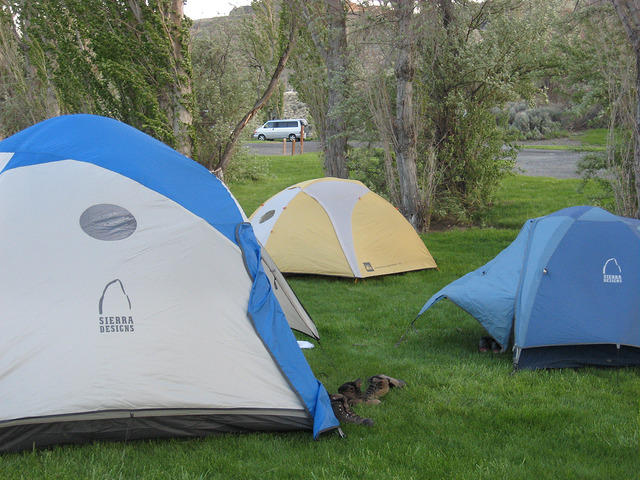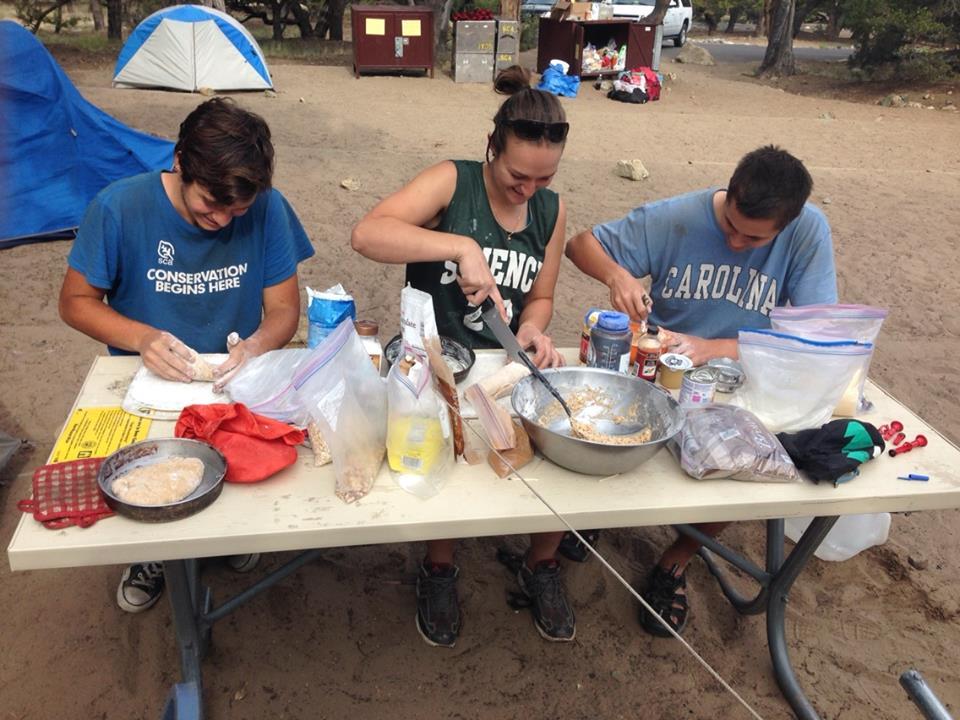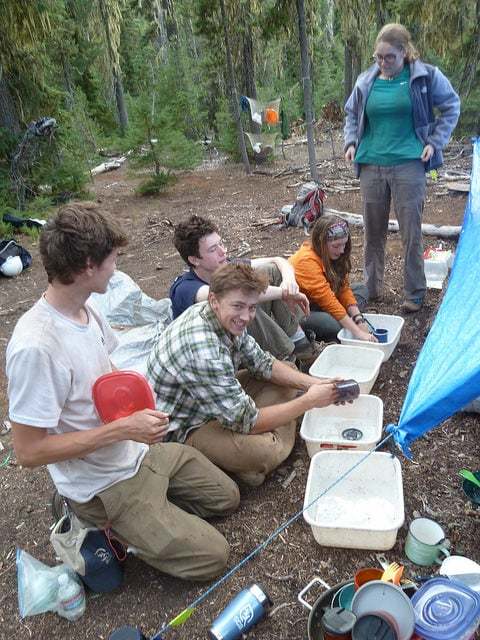Curious what it’s like to take part in a National, Regional or Tuition crew? Read on to learn what a typical day looks like, how members cook, eat and keep clean, and the many ways that this experience has changed people’s lives.

| Sunrise | Wake-up time! |
| 7:00 | Crew members prepare, eat and cleanup breakfast and pack lunches and backpacks for the day |
| 8:30 | Hike or drive to the project site |
| 9:00 | Members and leaders warm up their bodies and minds with stretches and word games, then review the work project and safety precautions for the day |
| 9:30 | Work on service project! Crews take breaks for snacks, lunch and water |
| 4:30 | Stop work to clean up tools and project area |
| 5:00 | Hike or drive back to the camp site |
| 5:30 | Members prepare, eat and clean up dinner, and get camp ready for the night |
| 8:00 | Members take part in formal or informal activities, games, and discussions |
| Darkness | Bedtime! |
*If you are on a Regional Commuting crew, your day would look very similar to this, with just a few differences. Commuting crew members pack their lunches at home. They meet up at a central location each morning and start their day with the “Hike or drive to the project site” section above. The crew day ends after they clean up their tools and hike or drive back to the central meeting location.

I felt a deep connection to the land and it put the work I had done for the last three weeks in perspective. This is the land we are protecting and conserving for future generations. To me, this made all of the long days and hard work worth is.
– 2018 Glacier National Park National Crew Member, Montana
Each crew works on conservation service projects that improve the park where they are serving. Since every park is different, service projects look different for every crew.
Here is a sampling:
As you can see, these are important projects that significantly improve the experience of park visitors and the health of local ecosystems. Go crews!
Your crew will be living in a frontcountry or backcountry setting.
Frontcountry: If you’re in a frontcountry site, you’ll be close to access roads and will usually have running water and use of a bathroom or outhouse. Your crew may be in a public campground with other campers as neighbors, or living it up at a private campsite not accessible to the public. Some front country crews even live in dormitories!


Backcountry: Backcountry crews are situated further from roads and don’t generally have running water or traditional bathroom facilities. If you’re on a backcountry crew, get ready to carry your gear, filter your water, and answer nature’s call the old-fashioned way.

SCA has a limited number of backcountry crews each year. Since these crews require members to live in the backcountry AND do heavy physical work every day, candidates must demonstrate successful experience either living in the backcountry, doing sustained physical labor, or both in order to be eligible.

My work ethic has changed and I’m inspired to go home and work really hard to improve myself and my community.
– 2016 Delaware Water Gap National Recreation Area National Crew Member, Pennsylvania
You might think that eating outside is all about peanut butter sandwiches, but there’s a whole lot more!
Crew members take turns preparing breakfasts and dinners, and can get really creative: from freshly baked bread and cinnamon buns, to sweet potato burritos and garlic mashed potatoes.
Some crew members have unique dietary needs based on their religion, life choices or allergies. Crew leaders shop with these in mind to make sure that all members have nourishing food to eat.
Crews usually pack lunches in the morning and eat them at the site where they are working.
Crew members play an important part in making sure that everything runs smoothly during the crew. They take turns cooking meals, cleaning dishes, collecting water, organizing tools, and many other daily tasks.

I found that the work experience I gained, the memories I created, the friends I created those memories with, and the places I’ve seen have made my life so much more fulfilling that to do this again would be an honor.
– 2018 Bristol Bay Native Corporation Regional Crew Member, Alaska
Clean hands
Clean hands are super important when you’re living outdoors and sharing food with lots of people! One member chore is usually making sure that the hand washing station is set up in camp and ready to go every day.
Clean bodies

Getting dirty is definitely part of the crew experience! It feels good to work hard and see the evidence of it on your muddy, dust-stained self at the end of the day.
Since many crews don’t have access to running water, crews learn other methods to clean up enough to keep their bodies healthy. On shorter crews, a quick dip in a pond or stream at the end of the day is enough to rinse off the grit. To do a more thorough job, you can learn to use biodegradable soap and shampoo to give yourself a “bucket bath”.
Clean clothes
We encourage members to limit the amount of clothing that they bring, so we know that it’s important for members to be able to clean their clothes (particularly socks and underwear).
Many crews head to a laundromat on their day off. Crew leaders provide laundry soap and pay for cleaning everyone’s clothes.
Crews who don’t have this option may learn about using biodegradable soap to wash their clothes with water from a stream or pond. There is nothing like putting on freshly cleaned clothes that dried in the sunshine!
Going to the bathroom
We know that some of you are wondering about this. Depending on your crew location, you might have a regular toilet with running water, a composting toilet, an outhouse, a latrine, or the option and tools to dig your own cat hole. If this is new to you, don’t worry! You can take care of all your personal needs even in the backcountry. It just takes learning some new techniques. Your crew leaders will teach you what you need to know to go to the bathroom in ways that are hygienic, private, and safe for the environment.
Girls going out on crews may be wondering what to do if they have their period while they’re out in the field. This link has some great tips about how women in the backcountry take care of this.
Having the right gear can mean the difference between a comfortable, safe experience, and weeks of discomfort and potentially dangerous conditions (like hypothermia!). Gear doesn’t have to be expensive, but does have to be adequate to meet the conditions that you’ll encounter in your position. Crew members use the Crew Gear List to make sure that they have the clothing and supplies necessary for a successful experience.
Crew members will wear personal protective equipment (PPE) as they work. Long pants and sturdy boots are always a must. You’ll wear gloves whenever handling certain tools or doing manual labor and a yellow SCA hard hat shall be worn whenever your crew is using specific tools. Other PPE, including safety glasses, mosquito repellant and dust masks will be used when the conditions or projects call for them. Your packing list will help you determine what gear to bring along.
Learning is integral to every part of the SCA crew experience.

Sometimes you’ll know when you’re learning, like when your crew leaders demonstrate how to use new tools, local experts share their knowledge about the community or park ecology, or your crew mate shares their famous coconut pancake recipe with you. At other times, you might not realize until later how much of an impact an experience has had on you.

My SCA experience has made me more confident, more qualified, and more ambitious than I was at the beginning of the summer. This experience put me to the test. SCA will certainly be a factor that bridges me from youth to adulthood, because I’m walking away with new skills in survival, team cooperation, leadership, construction work, and sustainable living. – 2016 Olympic National Forest National Crew Member, Washington
The most meaningful part of my SCA experience was talking to the other members of my crew and hearing about their various different planned paths, which was particularly influential as we were largely of the age to be leaving the nest, and hearing other choices people have made allows me to think more critically about what I want from my life, and what I want to choose for myself. – 2018 Region 8 National Crew Member, Louisiana
The feeling of laying down in your tent after a strenuous day of work was one of the most satisfying things I have ever felt. – 2017 Tuskegee National Crew Member, Alabama
The SCA gave me back a spark in my life that had grown dim. I gained confidence in myself and left with a sense of hope and a gleaming optimism. – 2016 Canyon De Chelly National Monument Regional Crew Member, Arizona
For me, SCA represents a space where I was pushed to grow mentally and physically, but was also surrounded by people who gave me an immense sense of security and community. – 2016 Big South Fork National River and Recreation Area National Crew Member, Tennessee
I realized that while a leader is valuable in a team, there needs to be someone who is willing to try any job that’s needed, and that’s something that I took on myself in the SCA crew. – 2018 Portland Parks National Crew Member, Maine
One day we were building a retaining wall, and we had to crush rocks with the sledgehammer to fill in the retaining wall. I spent all day swinging that sledgehammer and crushing rocks, and I have never felt more empowered. – 2017 Glacier National Park National Crew Member, Montana
I think I became more determined and more inclined to be a leader and make decisions. – 2018 New Jersey State Parks National Crew Member, New Jersey
